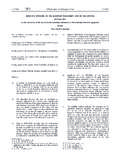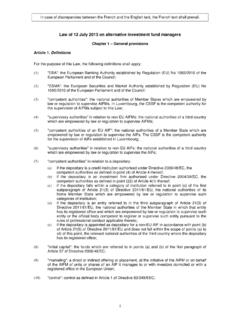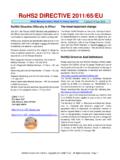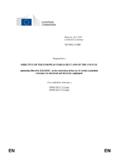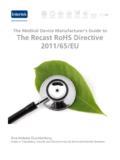Transcription of 12 December 2012 RoHS 2 FAQ - European …
1 12 December 2012 1 rohs 2 FAQ PREFACE .. 4 1. GENERAL .. 5 WHAT WAS THE INTENTION BEHIND THE rohs -RECAST? .. 5 WHAT IS THE DIFFERENCE BETWEEN directive 2002/95/EC ( rohs 1) AND directive 2011/65/EU ( rohs 2)? .. 5 WHEN DO THE NEW PROVISIONS OF rohs 2 APPLY? .. 6 WHY ARE THE HAZARDOUS SUBSTANCES RESTRICTED IN rohs 2 NOT RESTRICTED IN ALL PRODUCTS? .. 6 HOW ARE REACH AND rohs 2 RELATED TO EACH OTHER? .. 7 ARE BATTERIES WITHIN THE SCOPE OF rohs ?.. 7 HOW CAN I FIND OUT IF rohs 2 APPLIES TO MY PRODUCT? .. 7 WHERE CAN I ASK QUESTIONS ABOUT THE PROVISIONS OF rohs 2? .. 8 2. SCOPE ARTICLE 2(2) .. 8 WHAT DOES WITHOUT PREJUDICE TO ARTICLE 4(3) AND 4(4), MEMBER STATES SHALL PROVIDE THAT EEE THAT WAS OUTSIDE THE SCOPE OF directive 2002/95/EC, BUT WHICH WOULD NOT COMPLY WITH THIS directive , MAY NEVERTHELESS CONTINUE TO BE MADE AVAILABLE ON THE MARKET UNTIL 22 JULY 2019 MEAN? .. 8 WHICH PRODUCTS BENEFIT FROM THIS PROVISION?
2 (ARTICLES 2(2), 2(1), 3(1), 3(2), 4(3), 4(4)) .. 8 WHAT DOES MAKING AVAILABLE ON THE MARKET MEAN IN THIS CONTEXT? (ARTICLES 2(2), 3(11), 3(12)) .. 9 3. SCOPE LARGE-SCALE EXCLUSIONS .. 9 WHAT ARE "LARGE-SCALE STATIONARY INDUSTRIAL TOOLS" AND "LARGE-SCALE FIXED INSTALLATIONS"? (ARTICLES 2(4)(D) AND 2(4)(E)).. 9 DOES THE LSSIT/LSFI SCOPE EXCLUSION ALSO COVER EQUIPMENT SUCH AS IT AND TELECOMMUNICATION EQUIPMENT, MEDICAL DEVICES OR INDUSTRIAL MONITORING AND CONTROL INSTRUMENTS? .. 13 WHO IS RESPONSIBLE FOR ITEMS THAT ARE TO BE USED IN LSSIT/LSFIS? .. 13 4. SCOPE OTHER EXCLUSIONS .. 13 WHAT IS MEANT BY SPECIFICALLY DESIGNED EQUIPMENT (ARTICLE 2(4)C AND ARTICLE 2(4)J) .. 13 IS R&D EQUIPMENT EXCLUDED FROM rohs 2? .. 14 ARE EEE BUILT INTO BUILDINGS OUTSIDE OF SCOPE? .. 15 WHAT IS MEANT BY MULTIPLE OR DUAL USE?.. 15 IF EEE HAS MULTIPLE USES OF WHICH ONE IS IN THE SCOPE OF rohs 2, DOES THE EEE HAVE TO COMPLY ?
3 15 12 December 2012 2 CAN MULTIPLE USE EEE THAT IS NON-COMPLIANT BE SOLD FOR THE USE IN EXCLUDED PRODUCTS? .. 15 5. SCOPE CABLES .. 15 ARE CABLES WITHIN THE SCOPE OF rohs 2? .. 15 WHAT ARE THE REQUIREMENTS FOR INTERNAL WIRES AND INTERNAL CABLES? .. 16 WHAT ARE THE REQUIREMENTS FOR EXTERNAL CABLES? .. 16 6. GENERAL OPEN SCOPE .. 16 WHICH TYPES OF EQUIPMENT BENEFIT FROM THE EXCLUSIONS FROM THE SCOPE?.. 16 HOW DO I DECIDE WHICH CATEGORY OF EEE A PRODUCT FALLS IN? .. 17 DOES rohs 2 APPLY TO EEE FOR PROFESSIONAL AND INDUSTRIAL USE? .. 18 ARE TELECOMMUNICATION NETWORKS IN SCOPE? .. 18 ARE ELECTRIC BOARDS IN SCOPE? .. 18 ARE FUSE BOXES IN SCOPE? .. 18 ARE ACTIVE RFID TAGS IN SCOPE? .. 18 DOES PACKAGING HAVE TO COMPLY TO rohs 2? .. 19 HOW SHOULD PROFESSIONAL USE BE INTERPRETED? DOES IT APPLY ONLY AT THE FIRST PLACING ON THE MARKET, OR ALSO AT LATER STAGES? .. 19 7. EEE, COMPONENTS AND CONSUMABLES .. 19 IS MY PRODUCT EEE AS PER ARTICLES 3(1) AND (3)2?
4 19 WHAT DOES DEPENDENT ON ELECTRIC CURRENTS OR ELECTROMAGNETIC FIELDS MEAN? .. 20 DO COMPONENTS HAVE TO COMPLY WITH rohs 2? .. 20 ARE CONSUMABLES IN THE SCOPE? .. 21 8. CE MARKING, CONFORMITY ASSESSMENT PROCEDURES INCLUDING REQUIRED TECHNICAL DOCUMENTATION AND DECLARATION OF CONFORMITY .. 21 WHAT IS THE NEW LEGISLATIVE FRAMEWORK? .. 21 WHAT IS A DECLARATION OF CONFORMITY (DOC)? .. 22 WHAT DO I NEED TO INCLUDE IN MY TECHNICAL DOCUMENTATION? .. 22 HOW DO I HANDLE THE TRANSITION TO CE MARKING? .. 22 DO SPARE PARTS AND SUB-ASSEMBLIES NEED TO BE CE MARKED AND HAVE A DOC?22 DO I NEED TO CE MARK AND HAVE A DOC FOR rohs 2 FOR EQUIPMENT IN CATEGORIES 8 AND 9 AND OTHER EQUIPMENT NEWLY ENTERING THE SCOPE BEFORE THE SUBSTANCE RESTRICTIONS APPLY? .. 23 HOW DO I KNOW IF A PRODUCT IS ALREADY COMPLIANT WITH THE SUBSTANCE RESTRICTIONS, IF THE TRANSITION PERIOD IS STILL ONGOING? .. 23 IN TERMS OF CE MARKING, IS FINISHED PRODUCT (ARTICLE 7(C)) AND FINISHED EEE (ARTICLE 15(1)) THE SAME?
5 23 IF rohs 2 APPLIES TO A WHOLE PRODUCT, SHOULD I PREPARE A DOC AND CE RELATED TECHNICAL DOCUMENTATION FOR THE NON-EEE PART? .. 23 HOW CAN HARMONISED STANDARDS BE USED TO DEMONSTRATE COMPLIANCE? .. 24 12 December 2012 3 WHAT DOES A CE MARK ON EEE MEAN WITH REGARD TO THE RESTRICTED SUBSTANCES? .. 24 CAN I HAVE ANY rohs MARKS OTHER THAN THE CE MARK? .. 24 CONSIDERING THE TIME SPAN BETWEEN A PRODUCT BEING PLACED ON THE MARKET AND BEING EXAMINED BY A DISTRIBUTOR, WHEN DOES THE PRODUCT NEED TO BE IN COMPLIANCE WITH THIS directive ? .. 24 WHAT ARE THE PRODUCT MARKING REQUIREMENTS FOR TRACEABILITY REASONS? . 24 9. SUBSTANCE RESTRICTIONS AND EXEMPTIONS .. 25 WHAT IS THE DIFFERENCE BETWEEN rohs 1 AND rohs 2 REGARDING REQUIREMENTS FOR EXEMPTION? .. 25 ARE EXEMPTIONS GRANTED PER COMPANY, EQUIPMENT OR APPLICATION? .. 26 IS IT POSSIBLE TO CHECK IF AN EXEMPTION HAS BEEN APPLIED FOR?
6 26 HOW WILL RECENT EXEMPTIONS GRANTED UNDER rohs 1 APPLY TO rohs 2? .. 26 DOES THE EXCLUSION GRANTED BY ARTICLE 4(4)(F) APPLY TO ALL EXPIRED EXEMPTIONS, IRRESPECTIVE OF WHETHER OR NOT THE TEXT IN ANNEX III OR IV EXPLICITLY CONFIRMS THIS POINT? .. 27 WHAT ARE THE MAXIMUM CONCENTRATION VALUES FOR THE RESTRICTED SUBSTANCES, AND HOW DO I MAKE SURE THAT MY EEE COMPLIES? .. 27 DO THE SUBSTANCE RESTRICTIONS APPLY TO THE PRODUCTION PROCESS? .. 27 WHAT IS A HOMOGENEOUS MATERIAL? .. 27 ARE THERE SIMPLE METHODS FOR THE ANALYSIS OF HEXAVALENT CHROMIUM IN COATINGS? .. 28 HOW THICK DOES A COATING HAVE TO BE IN ORDER TO BE A HOMOGENOUS MATERIAL? .. 28 WHAT IS CLOSED-LOOP ? .. 28 12 December 2012 4 Preface In this document, directive 2002/95/EC on the restriction of the use of certain hazardous substances in electrical and electronic equipment (EEE) is referred to as rohs 1 and the recast directive 2011/65/EU is referred to as rohs 2.
7 directive 2011/65/EU entered into force on 21st July 2011 and requires Member States to transpose the provisions into their respective national laws by 2nd January 2013. The rohs 2 directive is part of the European Union's horizontal waste management legislation. This Frequently Asked Questions (FAQ) document is principally intended to help economic operators interpret the provisions of rohs 2 in order to ensure compliance with the directive s requirements. However, the directive being addressed only to the Member States, the rights and obligations for private parties exclusively flow from the measures enacted by the authorities of the Member States to implement it. The FAQ is considered a living document and may be revised in the future, according to the experience with the implementation and review of rohs 2. These FAQ reflect the views of DG Environment and as such are not legally binding: binding interpretation of EU legislation is the exclusive competence of the Court of Justice of the European Union.
8 These FAQ should be read in conjunction with the general principles of the New Legislative Framework (NLF) and the Commission s guide to the implementation of directives based on the New Approach and the Global Approach (hereafter referred to as the Blue Guide)1. The Commission launched a second impact assessment study on the scope changes going beyond the original recast proposal. The results of this study will be the basis for the 2014 scope review, which may lead to scope related adjustments. 1 12 December 2012 5 1. General What was the intention behind the rohs -recast? The rohs -recast was mainly aimed at developing better regulatory conditions. That means a simple, effective and enforceable directive ; increasing the level of legal clarity and certainty, including the facilitation of its harmonised enforcement; the adaptation of the directive to the technical and scientific progress concerning the use of hazardous substances in EEE particularly in medical devices and monitoring and control instruments; aligning and harmonising rohs with other EU legislation, such as the New Legislative Framework - Marketing of Products Package , REACH2, the ErP Directive3 and legislation related to management of waste from EEE with the objective to reduce administrative burden and to increase cost effectiveness; harmonising the implementation made in the different Member States.
9 And preventing risks to human health and the environment, with a particular focus on workers involved in the management of electronic waste. What is the difference between directive 2002/95/EC ( rohs 1) and directive 2011/65/EU ( rohs 2)? There are key differences between rohs 1 and rohs 2 in the following areas: 1. Scope a gradual extension of the requirements to all electrical and electronic equipment (EEE), cables and spare parts with a view to full compliance (except some exclusions4 that are explicitly stated in Article 2(4)) by 22nd July 2019; a clarification of important definitions (Article 3); provision for a review of the scope no later than July 2014 2. Restriction of new substances a methodology for the assessment of new hazardous substances in EEE with a view to restriction mainly based on waste-related criteria; a review of the list of restricted substances carried out by the Commission by July 2014, and periodically thereafter; an opportunity for Member States to propose new substance restrictions; 3.
10 Exemptions: clearer and more transparent rules for granting, renewing or deleting exemptions; obligation of manufacturers to apply for exemptions and to carry out the necessary assessment 2 Regulation (EC) No 1907/2006 of the European Parliament and of the Council of 18 December 2006 concerning the Registration, Evaluation, Authorisation and Restriction of Chemicals (REACH), establishing a European Chemicals Agency. 3 directive 2009/125/EC of the European Parliament and of the Council of 21 October 2009 establishing a framework for the setting of ecodesign requirements for energy-related products. 4 In principle, these scope exclusions can apply to any of the Annex I product categories. 12 December 2012 6 4. Coherence with other EU-Legislation: New Legislative Framework (CE marking and Declaration of Conformity); and Regulation (EC) No 1907/2006 on the Registration, Evaluation, Authorisation and Restriction of Chemicals (REACH).










